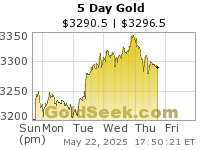src="http://pagead2.googlesyndication.com/pagead/show_ads.js">
src="http://pagead2.googlesyndication.com/pagead/show_ads.js">
In the Great Panic of 2008, the winners were those who held U.S. Dollars and short-term U.S. government debt (and those who shorted just about anything else). Almost every other asset class sunk in the carnage. It is felt by most market participants that the next big move down in the markets, which most who care about fundamentals know is coming at some point, that a replay of 2008 is most likely with "Dollar Up and Everything Else Down" the best template.
The complete and recently unrelenting complacency of those in the stock market is obvious based on basic factors like the Volatility Index ($VIX), put-to call-ratios (e.g., $CPC or $CPCE), sentiment figures (e.g., Investors Intelligence), insider sales and price-to-earnings ratios. General stock bears have been gored into submission (myself included) and seem foolish at this point. The risk in general equities is beyond ridiculous at this point, but that won't stop general stock market indices from going up further.
At some point, all of the gains since March of 2009 are likely to be wiped out. These lows may or may not hold, but a re-test is the most bullish scenario when looking over the longer term in my opinion. This could happen gradually or more dramatically. It is the latter that I am thinking about today.
I wanted to challenge the current wisdom, largely based on regurgitated lore and what happened in 2008, of what will happen if we experience another minor or major panic in the markets using the template of 1987. For those who want to argue that fundamentals were different then, I have no arguments. But a panic is a panic and has no relationship with fundamentals. Anyone who argues otherwise must explain how the value of stocks can change by over 30% within the course of a few weeks in the absence of a war or plague.
First, using the S&P 500 ($SPX) as a proxy, here is a daily linear scale plot of the stock market in the year 1987:

A "flight to safety" during a panic involves a rush to cash and short-term government debt according to conventional wisdom. A flight to safety did happen with 90 day T-Bills during the 1987 fall panic and they rose in price (i.e. yield dropped). But here is a daily chart of the 30 year U.S. Treasury Bond yield ($TYX) in 1987:

And here is a chart of the U.S. Dollar during 1987:

Next, a 1987 chart of the U.S. Dollar price of Gold ($GOLD) in 1987:

And now, for the bad news if you are a Gold stock bull. Here's a chart of the Philadelphia Gold and Silver Mining Index ($XAU) from 1987:

Gold stocks can move higher in the face of a stock bear market (and almost always do during secular Gold stock bull markets like the one we are in now), but are not spared in the setting of a stock market crash.
What are the lessons of 1987 for Gold bulls? First, as a cash-equivalent holding, Gold is safer than Gold stocks. Those who claim Gold was no safe haven during the Great Panic of 2008 forget to add a footnote that Gold was back at $1000/oz. (i.e. its 2008 high) by the end of February of 2009 while stocks were on their way to terrifying new lows. Gold stock indices, however, just re-tested their spring of 2008 highs for the first time last month. I remain wildly bullish on Gold stocks right now but do not intend to hold them if I "smell" a crash coming in the general stock market.
Second, the U.S. Dollar will by no means rocket insanely higher in the setting of a crash. It could, but it could just as easily crash or remain steady. I personally see a shift of a higher percentage of global assets into Gold over the Dollar this time around if another crash occurs. Because Gold is a small market, even a small shift of money flow from the Dollar to Gold would make the U.S. Dollar and Gold behave similarly to how they did in 1987. In other words, both would be fairly stable during the nasty part of the crash and then Gold would resume its bull market and the U.S. Dollar would resume its bear market.
Finally, I am by no means predicting a crash in the stock market or any other asset class. But stocks are overbought, ridiculously overvalued and sentiment is unbelievably bullish in the face of terrible economic fundamentals. Couple this with rising bond yields, particularly at the long end of the curve, and history suggests that returns in general equities over the next year are likely to be suboptimal to say the least.



